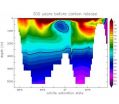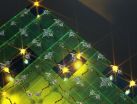(Press-News.org) Using a smart tablet and a red beam of light, Georgia Institute of Technology researchers have created a system that allows people to control a fleet of robots with the swipe of a finger. A person taps the tablet to control where the beam of light appears on a floor. The swarm robots then roll toward the illumination, constantly communicating with each other and deciding how to evenly cover the lit area. When the person swipes the tablet to drag the light across the floor, the robots follow. If the operator puts two fingers in different locations on the tablet, the machines will split into teams and repeat the process.
The new Georgia Tech algorithm that fuels this system demonstrates the potential of easily controlling large teams of robots, which is relevant in manufacturing, agriculture and disaster areas.
"It's not possible for a person to control a thousand or a million robots by individually programming each one where to go," said Magnus Egerstedt, Schlumberger Professor in Georgia Tech's School of Electrical and Computer Engineering. "Instead, the operator controls an area that needs to be explored. Then the robots work together to determine the best ways to accomplish the job."
Egerstedt envisions a scenario in which an operator sends a large fleet of machines into a specific area of a tsunami-ravaged region. The robots could search for survivors, dividing themselves into equal sections. If some machines were suddenly needed in a new area, a single person could quickly redeploy them.
The Georgia Tech model is different from many other robotic coverage algorithms because it's not static. It's flexible enough to allow robots to "change their minds" effectively, rather than just performing the single job they're programmed to do.
"The field of swarm robotics gets difficult when you expect teams of robots to be as dynamic and adaptive as humans," Egerstedt explained. "People can quickly adapt to changing circumstances, make new decisions and act. Robots typically can't. It's hard for them to talk and form plans when everything is changing around them."
In the Georgia Tech demonstration, each robot is constantly measuring how much light is in its local "neighborhood." It's also chatting with its neighbor. When there's too much light in its area, the robot moves away so that another can steal some of its light.
"The robots are working together to make sure that each one has the same amount of light in its own area," said Egerstedt.
The tablet-based control system has one final benefit: it was designed with everyone in mind. Anyone can control the robots, even if they don't have a background in robotics.
"In the future, farmers could send machines into their fields to inspect the crops," said Georgia Tech Ph.D. candidate Yancy Diaz-Mercado. "Workers on manufacturing floors could direct robots to one side of the warehouse to collect items, then quickly direct them to another area if the need changes."
A paper about the control system, "Multi-Robot Control Using Time-Varying Density Functions," was recently published in the IEEE Transactions on Robotics (T-RO).
INFORMATION:
This material is based upon work supported by the Air Force Office of Scientific Research under Award No. FA9550-13-1-0029. Any opinions, findings and conclusions or recommendations expressed in this publication are those of the authors and do not necessarily reflect the views of the AFOSR.
Diet exerts a major impact on health and ageing. The nervous system plays an important role in this process but, thus far, how food signals are interpreted by the nervous system has been a mystery. This is an important question because the perception of food by the nervous system impacts not just ageing, but also other processes associated with health and disease, including metabolism, reproduction, and development.
A new study published in eLife by researchers from the MRC Centre for Developmental Neurobiology (MRC CDN) at the Institute of Psychiatry, Psychology & Neuroscience ...
To measure distances in the Universe, astronomers use Cepheids, a family of variable stars whose luminosity varies with time. Their role as distance calibrators has brought them attention from researchers for more than a century. While it was thought that nearly everything was known about the prototype of Cepheids, named Delta Cephei, a team of researchers at the University of Geneva (UNIGE), the Johns Hopkins University, and the European Space Agency (ESA), have now discovered that this star is not alone, but that it has a hidden companion. A revelation published in The ...
MADISON, Wis. -- Expansion of cattle pastures has led to the destruction of huge swaths of rain forest in Brazil, home to the world's largest herd of commercial beef cattle. But a new study led by the University of Wisconsin-Madison's Holly Gibbs shows that market-driven "zero deforestation agreements" have dramatically influenced the behavior of ranchers and the slaughterhouses to which they sell.
Publishing today [May 12, 2015] in the journal Conservation Letters, the research team - including other UW-Madison scientists, the National Wildlife Federation, and IMAZON ...
Scientists from Oregon State University have discovered that fish can produce their own sunscreen. They have copied the method used by fish for potential use in humans.
In the study published in the journal eLife, scientists found that zebrafish are able to produce a chemical called gadusol that protects against UV radiation. They successfully reproduced the method that zebrafish use by expressing the relevant genes in yeast. The findings open the door to large-scale production of gadusol for sunscreen and as an antioxidant in pharmaceuticals.
"The fact that the compound ...
Extremely high levels of cardiovascular risk factors have been found in people with established psychosis, with central obesity evident in over 80 per cent of participants, in a study by researchers from the NIHR Biomedical Research Centre at the South London and Maudsley NHS Foundation Trust (SLaM) and King's College London.
In the largest study of its kind in the UK, drawing on a sample of more than 400 outpatients with psychosis, it was discovered that nearly half of the sample were obese (48 per cent), with a body mass index (BMI) of 30 or more. Additionally, nearly ...
Around 55 million years ago, an abrupt global warming event triggered a highly corrosive deep-water current to flow through the North Atlantic Ocean. The origin of this corrosive water has puzzled scientists for a decade.
Now, researchers have discovered this current and how it formed. The findings, published today in Nature Geoscience, also have profound implications for the sensitivity of our current climate to carbon dioxide emissions.
The researchers explored the acidification of the ocean that occurred during a period known as the Paleocene Eocene Thermal Maximum ...
A low platelet count can occur as the result of a variety of medical conditions and as a medication side effect. Platelet transfusion is often required for individuals with a critically low platelet level. Currently, the primary source of platelets is volunteer donors. Unfortunately, donated platelets have an extremely short shelf life and can be in limited supply. A new study in the Journal of Clinical Investigation reports on a method to generate progenitor cells from murine embryonic stems that are able to produce a large number of functional platelets. Mitchell Weiss ...
Bacterial meningitis is a life-threating infection of the central nervous system. Group B Streptococcus (GBS) is the leading cause of meningitis in newborn babies and can cause severe complications in those that survive the infection. GBS must cross the blood-brain-barrier (BBB) to cause disease but it is not clear how these organisms breach this barrier. A new study in the Journal of Clinical Investigation identifies a pathway that is induced by GBS and disrupts junctions between cells. Kelly Doran and colleagues at San Diego State University determined that GBS induces ...
PROSSER, Wash. - Washington wine grape vineyards experimenting with sustainable pest management systems are seeing an unexpected benefit: an increase in butterflies.
Over the years, loss in natural habitat has seen the decline in numbers of around 50 species of butterflies in eastern Washington. But in a recent Washington State University study published in the June issue of the Journal of Insect Conservation, researchers found that vineyards that create nearby natural habitats have three times the number of butterfly species and four times more butterflies than conventional ...
In what marks a significant step forward for artificial intelligence, researchers at UC Santa Barbara have demonstrated the functionality of a simple artificial neural circuit. For the first time, a circuit of about 100 artificial synapses was proved to perform a simple version of a typical human task: image classification.
"It's a small, but important step," said Dmitri Strukov, a professor of electrical and computer engineering. With time and further progress, the circuitry may eventually be expanded and scaled to approach something like the human brain's, which has ...





